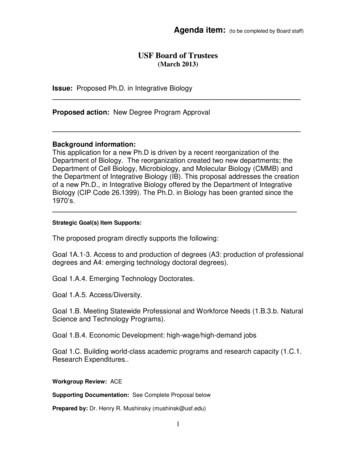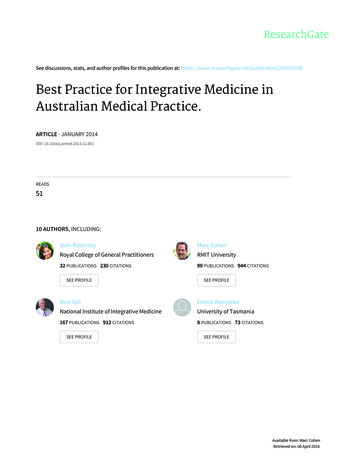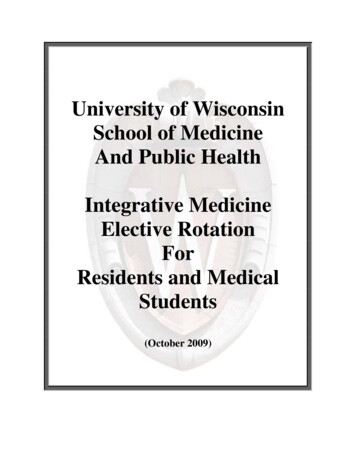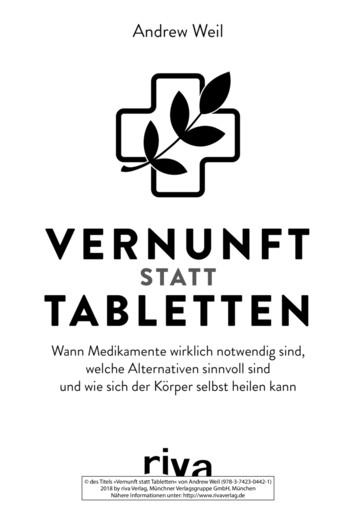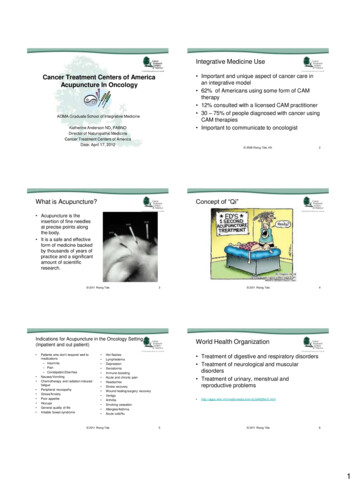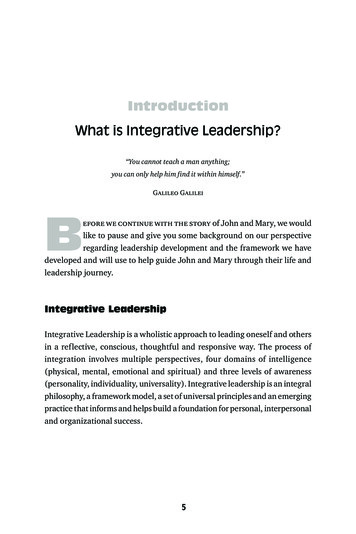
Transcription
IntroductionWhat is Integrative Leadership?“You cannot teach a man anything;you can only help him find it within himself.”Galileo GalileiBefore we continue with the story of John and Mary, we wouldlike to pause and give you some background on our perspectiveregarding leadership development and the framework we havedeveloped and will use to help guide John and Mary through their life andleadership journey.Integrative LeadershipIntegrative Leadership is a wholistic approach to leading oneself and othersin a reflective, conscious, thoughtful and responsive way. The process ofintegration involves multiple perspectives, four domains of intelligence(physical, mental, emotional and spiritual) and three levels of awareness(personality, individuality, universality). Integrative leadership is an integralphilosophy, a framework model, a set of universal principles and an emergingpractice that informs and helps build a foundation for personal, interpersonaland organizational success.5
Integrative LeadershipOur Leadership BeliefsIn our years as reflective practitioners of leadership we have come to believethat leadership is: Everyone’s business, regardless of position or situation. Everyone hasthe capacity to lead. Leadership is a choice. Development of the whole person. All leadership development isultimately self-development. About people and process, whereas management is about the workand goals. Both are needed for sustainable success. About meaningful and purposeful relationships with yourself andothers. About producing transactional, transformational and transcendentchange, individually and organizationally. About an outside story (actions, behaviors, opinions) and an insidestory (intentions, thoughts, feelings) that require balance, truth,compassion and wisdom to be effectively integrated. About learning. Leaders are learners who learn by a) experience,b) accessing role models, coaches, mentors, and counselors, andc) education, training and development. We have found that everyonecan, through patient and consistent practice, become a better leader.We believe that the greatest leverage to being a responsive, Integrative Leaderis through personal development addressing multiple perspectives, all fourintelligences, all three levels of awareness, and awakening and effectivelyusing our power of choice.Evolution and InvolutionIn leadership development we can move from the outside in, which we callevolution, or from the inside out, which we call involution. These two forces ofchange and development have been with us since the beginning of time. If weare influenced more by actions, behaviors and our senses, then we are moreevolutionary in our approach to life. If we are influenced more by our core6
What is Integrative Leadership?values, beliefs, principles and intuitions that can help us reshape our attitudesand emotions and inform our behaviors, then we are more involutionary. 1Both these processes are happening for us simultaneously. We will discussthis further in Chapter 1, with two complementary forces—separation andintegration—discussed in Chapter 2.The Coming Age of IntegrationWe have moved through various ages in the history of humankind. We haveevolved from walking on hind legs nearly ten million years ago to beinghunters, gatherers, nomads, shepherds, farmers, industrialists,informationalists and knowledge masters. Today, we are entering a new ageof wisdom, synthesis and integration. This new age is the subject of debate onhow it will impact our global socio-economic framework over the next decade.Integrative Leaders will thrive in this coming time of transition by willinglyawakening, developing and utilizing more of their natural human potential.We will discuss this coming Age of Integration more fully in Chapter 3.Building a Model of Integrative LeadershipTMMultiple PerspectivesIntegrative Leaders see the world from multiple perspectives. This isfundamental to developing creativity, adaptability and flexibility. Withoutthis ability, we can only see the world through our own narrow perspective.In any exchange, we need to suspend for a moment our own beliefs andattitudes to allow ourselves to see the others. Without this openness andcuriosity about life and people, we remain rigid in our thinking. These rigidbeliefs act as barriers to seeing the world as it truly is, and move us insteadto seeing our world only as we are.Four Domains of IntelligenceThe four domains of intelligence are physical, mental, emotional and spiritual.The physical involves impulsive, instinctive thinking; the mental involvesserial thinking; the emotional, associative thinking; and the spiritual, unitive7
Integrative Leadershipthinking. The latter three all use the physical domain to express themselvesin the world. Whereas management primarily focuses on actions andthoughts, leadership also focuses on feelings and intentions. An IntegrativeLeader awakens, develops and uses all four domains of intelligence to informevaluating, decision-making, problem solving and planning processes.Three Levels of AwarenessIn our work, we also observed that there are three levels of awareness thatinfluence our journey of life and leadership.The first level is about our personality, our image of self, or what we callour Surreal Self that we publicly show to the world. This level is oftensuperficial and skims the surface of who we really are, and captures much ofour waking attention. When this intoxication with our worldly life becomesunfulfilling, our search for fulfillment can move our attention upwards andinwards to more fully engage our second level of awareness.Level II awareness is about our Individuality or Character that is our moreprivate thoughts and feelings about our world and is the home of our RealSelf. From Level II awareness, our attention can be drawn back to the noise,glamour and glimmer of Level I awareness, or our search for lastingfulfillment can move our attention higher and more deeply inward to fullyengage our Level III awareness.Level III awareness is about our Universality or Essence and is the homeof our True Self. It is the level from which wisdom, higher knowledge, genuinecompassion, authentic happiness, original inspirations and higher sensoryperception flow into our conscious Level I awareness. This flow serves tonot only capture, but also enrapture, enlighten and illuminate our attention.Our Ideal is a consciously formulated image of who we would like to become.It can be attuned to and motivated by any of our three levels of awareness.The highest of what we can conceive as the best of human qualities andvirtues is our Ideal Self. As we attune, apply and embody our Ideal in ourdaily life, our knowledge and understanding of our Ideal will evolve and intime, will become more and more aligned, harmonious and resonant withour True Self. This is the aim or goal of the journey and process of integration.When we compare our Ideal Self to our Real and Surreal Selves, we find thatthere are some alignments, overlaps and areas of strengths upon which wecan build. And we also find that there are misalignments, separations and8
What is Integrative Leadership?areas for development. The separation between our three levels of awarenesswe call the Being-Knowing-Doing Gap.2Building on our alignments and strengths while reducing and minimizingthese gaps is an essential part of the journey to becoming an Integrative Leader.A Fifth Domain: The Power of ChoiceThe method for negotiating through the four domains of our intelligenceand the three levels of our awareness is awakening and utilizing our powerof will, choice and desire.For the majority, our will is either mesmerized, hypnotized or asleep whileimmersed in Level I awareness. Awakening our personal will is a step alongthe path of integration that is first seen as negation, then negotiation andfinally affirmation. The phase of affirmation leads to full conscious,responsible and accountable development of our personal will. The final stepon the path towards integration is to allow our personal will to be informedand transformed into our Higher Will so that more of our True Self can beembodied in our world.We will deal more fully with the four domains of intelligence, three levelsof awareness and the power of choice in Chapter 4, Building a Model ofIntegrative Leadership.The Process of Becoming an Integrative LeaderThe journey of becoming an Integrative Leader can be described in variousways. It is about making the unconscious conscious. It is about balancingand harmonizing our inner and outer stories. It is about integrating ourvarious personality roles into a more congruent and cohesive whole amongmany other similar perspectives.Each leader has a unique path to walk for personal and professionaldevelopment and integration. However, there are some similar patterns,perspectives and processes that seem to be the same for all who havesuccessfully walked the path of integrative life and leadership that involvechange, choice and approach.There are three processes of change: transactional, associated with LevelI awareness; transformational, associated with Level II awareness; and9
Integrative Leadershiptranscendent, associated with Level III awareness. All three processes areevident in the journey of integrative life and leadership.There are fundamentally two choices before us in every situation we mayencounter. We can either react from our past habits and image of self, orrespond in accordance with our Ideal Self. One choice leads to samenessand mediocrity and the other to growth and adventure. Cultivating thepractice of reflection becomes a key that will help to inform your choice inthe present moment.Just as there are two fundamental choices, there are also two fundamentalapproaches to the journey of integration. One is the path of struggle. Theother is the path of flow. The path of struggle has been called the ‘crucibleof leadership’3 and is often characterized by crisis, drama, loss and trauma.85% of the world currently walks the path of struggle. The path of flow hasbeen called ‘awakening the soul of leadership’ and is characterized by peakexperiences, awe, wonder, grace and adventure. 15% of the world currentlywalks the path of flow.4 Cultivating the practices of awareness and attentionwill help you apprehend the messages from your inner and outer life thatwill in turn help your journey of integration have more flow and less struggle.Chapter 5, The Process of Becoming an Integrative Leader, will move intomore detail about these aspects of the journey as well as the seven elementsof becoming an Integrative Leader.Guidelines for Becoming an Integrative LeaderThe foundational guidelines for the integrative journey are Universal Lawsthat operate everywhere, all the time, on everyone and everything. Theyare beyond belief because, for example, whether or not you believe in thelaw of gravity, it still works. Awareness of these Universal Laws and seekingto align, apply and understand them will help you successfully navigate yourpersonal journey of integration.The eight Universal Laws, twelve principles for strengtheningrelationships and twelve Integrative, Transformative & Transcendent (ITT)Practices, if habituated, become a natural life-giving response to the everchanging events of your life.10
What is Integrative Leadership?We will share our understanding of these Universal Laws, principles andassociated practices more fully in Chapter 6.Organizational IntegrationOrganizationTM: Building a LivingFor an organization to be alive, its constituents must number among the livingas opposed to the living dead. The process of integration is one that helpsrenew and awaken new life in individuals, and by association, theorganizations they serve.Applying the integrative leadership philosophy, principles and practicesto an organization can help its culture transform from a surviving to a thrivingone. This process, which we call Organizational Integration, will allow themto be engaged, enthused and inspired to make a meaningful difference. Wewill share some further thoughts and ideas about Organizational Integrationand Building a Living Organization in Chapter 7.An Emerging Integral PhilosophyOver the past three years, Integrative Leadership has evolved into aphilosophy, worldview or integrative paradigm. The key points that comprisethis philosophy are: Everybody and every body of knowledge contain a portion of thetruth, but no one body at this time contains it all. Life is our teacher and our Ideal Self is our guide. Our life providesour life and leadership curriculum. Everyone can become their Ideal Self by having the courage toexperiment and practice new behaviors. The process of becoming our Ideal Self is as important as the goal.Balance between our process and goal orientations is important forsuccessfully walking the path of integration. An unreflective life is not worth living. Without regular periodic lifereviews, we tend to repeat the mistakes of our past image of self.11
Integrative Leadership We are more than our actions, thoughts and feelings. Within us residesa vast untapped and unexplored sea of energy, information andpotential. Tapping into this sea of energy and information andallowing it to move with us and through us becomes the path of flow. Higher-order integrative thinking can solve old problems in oftenunique and surprising ways. There is a shadow side and a light side within every leader.Acknowledging and dealing with our shadow side while emphasizingthe light side are necessary parts of the process of becoming anIntegrative Leader.We hope that you see a reflection of your own life and leadership journey inJohn’s, Mary’s and our own, and that it will give you more clarity, new insightsand a heightened awareness of who you are and what you want to do withthis gift of life we have all been given.12
Integrative Leadership 6 Our Leadership Beliefs In our years as reflective practitioners of leadership we have come to believe that leadership is: Everyone's business, regardless of position or situation. Everyone has the capacity to lead. Leadership is a choice. Development of the whole person. All leadership development is
